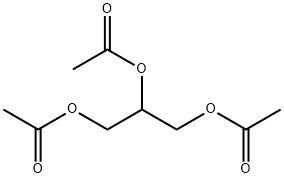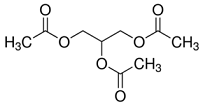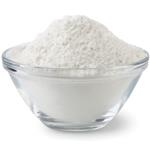
Triacetate
- Product NameTriacetate
- CAS102-76-1
- CBNumberCB00130413
- MFC9H14O6
- MW218.2
- EINECS203-051-9
- MDL NumberMFCD00008716
- MOL File102-76-1.mol
- MSDS FileSDS
Chemical Properties
| Melting point | 3 °C(lit.) |
| Boiling point | 258-260 °C(lit.) |
| Density | 1.16 g/mL at 25 °C(lit.) |
| vapor density | 7.52 (vs air) |
| vapor pressure | 0.00248 mm Hg @ 250C |
| FEMA | 2007 | (TRI-)ACETIN |
| refractive index | n |
| Flash point | 300 °F |
| storage temp. | Sealed in dry,Room Temperature |
| solubility | Soluble in water, miscible with ethanol (96 per cent) and toluene. |
| form | Liquid |
| color | Clear colorless |
| Odor | Characteristic odour |
| PH | 5.0-6.0 (20°C, 50g/L in H2O) |
| biological source | synthetic |
| Odor Type | fruity |
| explosive limit | 1.05%, 189°F |
| Water Solubility | 64.0 g/L (20 ºC) |
Safety
| Symbol(GHS) |

|
|||||||||
| Signal word | Warning | |||||||||
| Hazard statements | H303 | |||||||||
| Precautionary statements | P270-P301+P312-P403-P501c | |||||||||
| Safety Statements | 23-24/25 | |||||||||
| WGK Germany | 1 | |||||||||
| RTECS | AK3675000 | |||||||||
| Autoignition Temperature | 809 °F | |||||||||
| TSCA | Yes | |||||||||
| HS Code | 29153930 | |||||||||
| Hazardous Substances Data | 102-76-1(Hazardous Substances Data) | |||||||||
| Toxicity | LD50 i.v. in mice: 1600 ±81 mg/kg (Wretlind) | |||||||||
| NFPA 704: |
|





